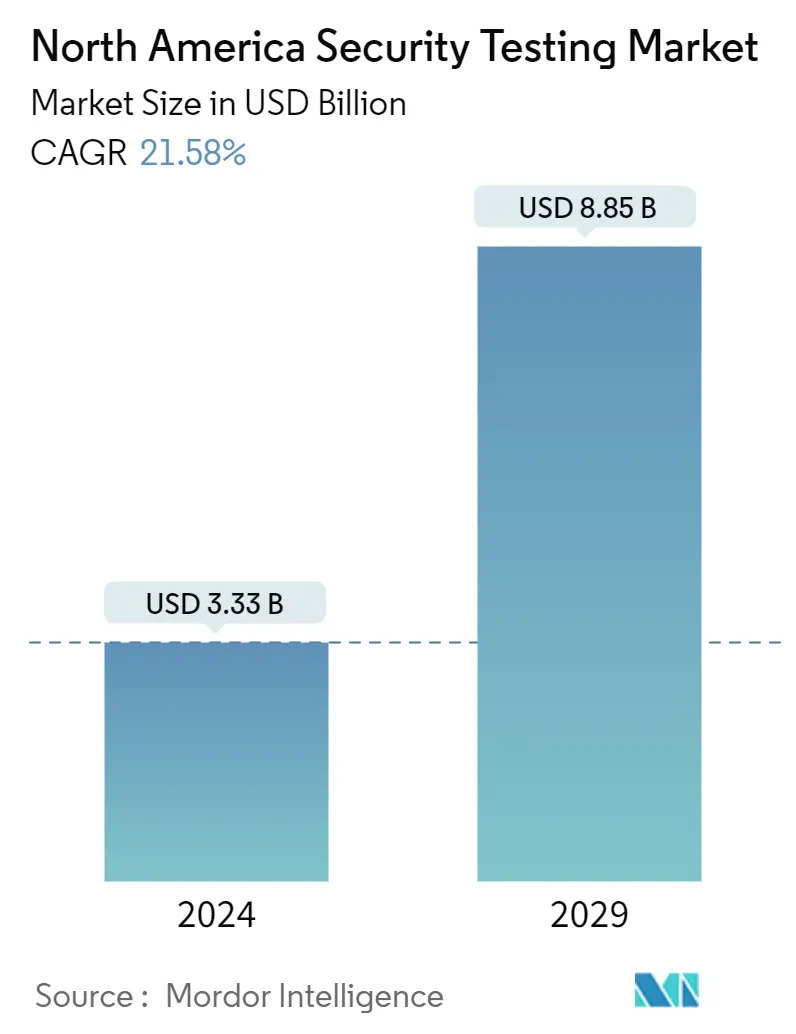Market Size of North America Security Testing Industry

| Study Period | 2019 - 2029 |
| Base Year For Estimation | 2023 |
| Market Size (2024) | USD 3.33 Billion |
| Market Size (2029) | USD 8.85 Billion |
| CAGR (2024 - 2029) | 21.58 % |
| Market Concentration | Low |
Major Players
*Disclaimer: Major Players sorted in no particular order |
North America Security Testing Market Analysis
The North America Security Testing Market size is estimated at USD 3.33 billion in 2024, and is expected to reach USD 8.85 billion by 2029, growing at a CAGR of 21.58% during the forecast period (2024-2029).
North America is a highly regulated region globally with numerous regulations and compliances, such as the Federal Energy Regulatory Commission (FERC), HIPAA, PCI DSS, and SOX, across verticals. North American companies are quite advanced at deploying security, penetration testing, and vulnerability management solutions and have best practices for everyday business processes, thereby driving the adoption of penetration testing solutions.
- The North American region is a technology hub. Therefore, the federal government has made very stringent rules regarding security testing services. Moreover, it is compulsory for industries, such as BFSI, to adhere to compliance testing.
- The increasing need for safety from security threats is driving the growth of the security testing market. The combination of digital transformation initiatives, cloud computing, IoT, and regulatory requirements has created a demand for comprehensive security testing services to help organizations identify and address vulnerabilities in their systems, applications, and digital infrastructure.
- Government regulations play a significant role in driving the security testing market. Governments in North America have recognized the importance of cybersecurity and have introduced regulations and standards to ensure the protection of sensitive data, critical infrastructure, and citizen privacy.
- Organizations unaware of the benefits of security testing may be less likely to adopt such practices. They might need to pay more attention to the importance of proactive security measures and rely solely on reactive measures like incident response and recovery. This limited adoption of security testing can hinder the growth of the market.
- With the widespread COVID-19, the adoption of remote work, securing remote access to corporate networks and resources became a top priority. Organizations invested in security testing to assess the security of their remote access infrastructure, including virtual private networks (VPNs), remote desktop protocols, and other remote connectivity solutions. Security testing helped identify vulnerabilities in these systems and ensured that remote access was adequately protected.
North America Security Testing Industry Segmentation
Security testing is software testing that intends to uncover vulnerabilities in the system and determine that its data and resources are protected from intruders. Security testing of any system is about finding all the possible loopholes and weaknesses that may result in the organization's loss of information, revenue, and reputation at the hands of employees or outsiders.
North America Security Testing Market is Segmented by Deployment (On-premise, Cloud, Hybrid), Type (Network Security Testing (VPN Testing, Firewall Testing), Application Security Testing (Application Type (Mobile Application Security Testing, Web Application Security Testing, Cloud Application Security Testing, Enterprise Application Security Testing), Testing Type (SAST, DAST, IAST, RASP)), by Testing Tool (Web Application Testing Tool, Code Review Tool, Penetration Testing Tool, Software Testing Tool), by End-user Industry (Government, BFSI, Healthcare, Manufacturing, IT and Telecom, Retail), by Country (United States, Canada). The market sizes and forecasts are provided in terms of value in USD for all the above segments.
| By Deployment | |
| On-premise | |
| Cloud | |
| Hybrid |
| By Type | ||||||||||||||
| ||||||||||||||
|
| By Testing Tool | |
| Web Application Testing Tool | |
| Code Review Tool | |
| Penetration Testing Tool | |
| Software Testing Tool | |
| Other Testing Tools |
| By End-user Industry | |
| Government | |
| BFSI | |
| Healthcare | |
| Manufacturing | |
| IT and Telecom | |
| Retail | |
| Other End-user Industries |
| By Country | |
| United States | |
| Canada |
North America Security Testing Market Size Summary
The North American Security Testing Market is poised for significant growth, driven by the region's stringent regulatory environment and the increasing need for robust cybersecurity measures. As a technology hub, North America has implemented numerous regulations across various sectors, including healthcare and finance, to safeguard sensitive data and critical infrastructure. The adoption of security testing solutions, such as penetration testing and vulnerability management, is being propelled by the digital transformation initiatives, cloud computing, and the Internet of Things (IoT). These factors have created a heightened demand for comprehensive security testing services to identify and mitigate vulnerabilities in systems and applications. The market is characterized by the presence of major players like Hewlett Packard Enterprise, IBM, and Cisco Systems, who are actively engaging in partnerships and acquisitions to enhance their offerings and maintain a competitive edge.
The healthcare sector, in particular, underscores the importance of security testing to protect patient data and ensure compliance with regulations like HIPAA. The proliferation of connected medical devices and the need to secure remote access infrastructure, especially post-COVID-19, have further emphasized the necessity of proactive security measures. Despite the growing awareness of cybersecurity threats, some organizations remain hesitant to fully embrace security testing, relying instead on reactive measures. This reluctance can impede market growth. However, the increasing recognition of the importance of cybersecurity, coupled with government initiatives and funding, is expected to drive the market forward, as organizations invest in securing their digital infrastructure against evolving threats.
North America Security Testing Market Size - Table of Contents
-
1. MARKET DYNAMICS
-
1.1 Market Overview
-
1.2 Value Chain/Supply Chain Analysis
-
1.3 Industry Attractiveness - Porter's Five Forces Analysis
-
1.3.1 Bargaining Power of Buyers
-
1.3.2 Bargaining Power of Suppliers
-
1.3.3 Threat of New Entrants
-
1.3.4 Threat of Substitute Products
-
1.3.5 Intensity of Competitive Rivalry
-
-
1.4 Assessment of the COVID-19 Impact on the Industry
-
-
2. MARKET SEGMENTATION
-
2.1 By Deployment
-
2.1.1 On-premise
-
2.1.2 Cloud
-
2.1.3 Hybrid
-
-
2.2 By Type
-
2.2.1 Network Security Testing
-
2.2.1.1 VPN Testing
-
2.2.1.2 Firewall Testing
-
2.2.1.3 Other Service Types
-
-
2.2.2 Application Security Testing
-
2.2.2.1 Application Type
-
2.2.2.1.1 Mobile Application Security Testing
-
2.2.2.1.2 Web Application Security Testing
-
2.2.2.1.3 Cloud Application Security Testing
-
2.2.2.1.4 Enterprise Application Security Testing
-
-
2.2.2.2 Testing Type
-
2.2.2.2.1 SAST
-
2.2.2.2.2 DAST
-
2.2.2.2.3 IAST
-
2.2.2.2.4 RASP
-
-
-
-
2.3 By Testing Tool
-
2.3.1 Web Application Testing Tool
-
2.3.2 Code Review Tool
-
2.3.3 Penetration Testing Tool
-
2.3.4 Software Testing Tool
-
2.3.5 Other Testing Tools
-
-
2.4 By End-user Industry
-
2.4.1 Government
-
2.4.2 BFSI
-
2.4.3 Healthcare
-
2.4.4 Manufacturing
-
2.4.5 IT and Telecom
-
2.4.6 Retail
-
2.4.7 Other End-user Industries
-
-
2.5 By Country
-
2.5.1 United States
-
2.5.2 Canada
-
-
North America Security Testing Market Size FAQs
How big is the NA Security Testing Market?
The NA Security Testing Market size is expected to reach USD 3.33 billion in 2024 and grow at a CAGR of 21.58% to reach USD 8.85 billion by 2029.
What is the current NA Security Testing Market size?
In 2024, the NA Security Testing Market size is expected to reach USD 3.33 billion.

